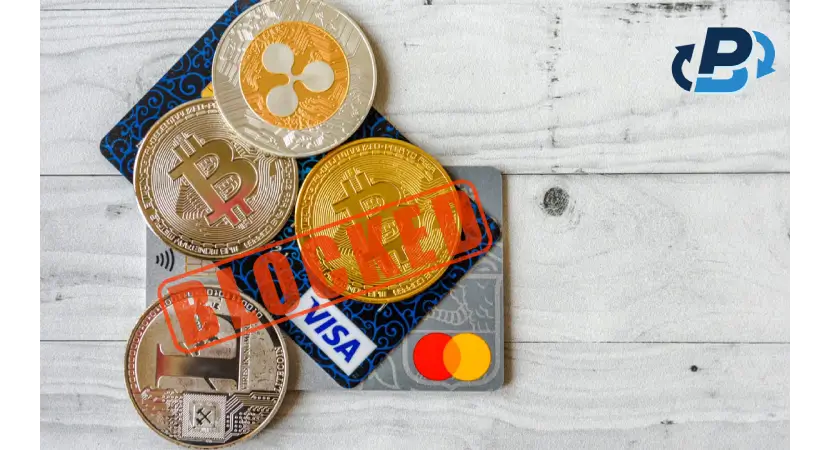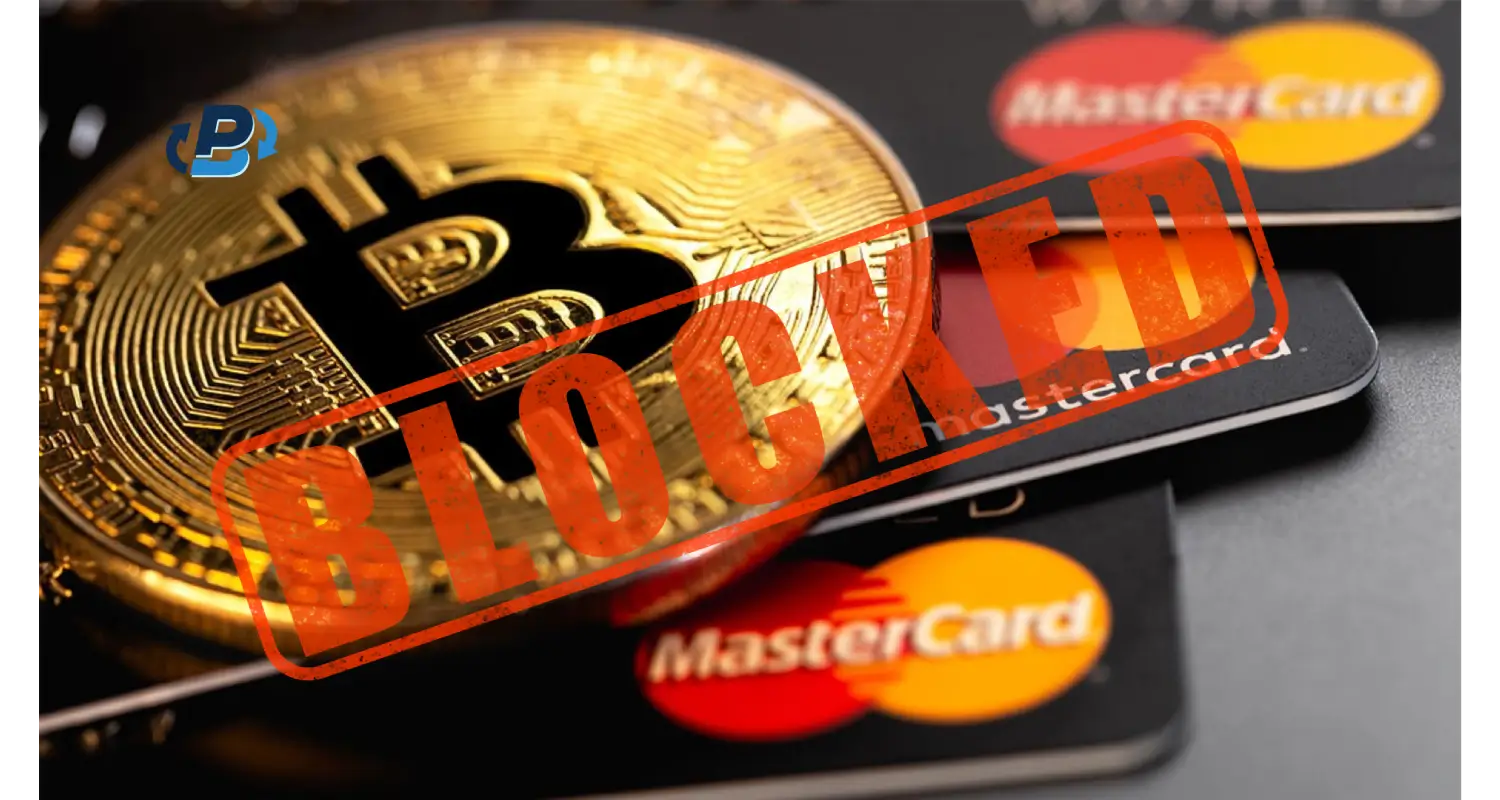Though blockchain technology is approaching mainstream status, most banks still try to steer clear of crypto-related businesses. Credit card issuers often have policies that automatically decline any purchase of a cryptocurrency, which leaves their clients asking why is my card blocked for buying crypto? Banks tend to block these transactions because they consider cryptocurrency a high-risk sector, associated with scams, disputes, and chargebacks like gambling, adult entertainment, and the supplements market.
This article digs into why banks are so cautious about crypto transactions and compares crypto to other high-risk industries. We’ll also share some practical tips on how you can avoid these blocks when buying crypto, whether by giving your bank a heads-up, using a bank transfer, or opting for alternatives like Bitcoin ATMs and peer-to-peer trading platforms.
Why Are Creditors Wary of Crypto Purchases?
Cryptocurrency offers a lot of opportunities for profit, but let's be honest—it's something of a rollercoaster ride. And nobody knows this better than banks and credit card companies, which is why they tiptoe around crypto businesses. Why are they so cautious? Well, there are three good reasons.
1. Chargeback Risks and Fraudulent Transactions
A chargeback is exactly what it sounds like. When a customer disputes a charge and wins, the bank has to give the customer back his or her money. At first glance, that might seem as unfair to you as it does to the banks. But ironically enough, the rule is enforced by the Fair Credit Billing Act, which was put in place to protect consumers from fraud. So if a client disputes a relatively recent crypto purchase, the bank is required to refund their money pending an investigation.
Now, here’s the kicker with crypto: Unlike most purchases, where the goods can be returned or the service canceled, blockchain transactions are irreversible by their very nature. So all a scammer has to do is get their hands on a crypto wallet temporarily, and they can empty it. And if a scammer gains access to an exchange account connected to a funding method, they might clear out a user’s bank account too. The bank is basically left holding the client’s bag.
2. Buyer’s Remorse and Fraudulent Claims
Another scenario that keeps banks up at night is the tendency of buyer’s remorse. Picture this: An enthusiastic crypto newbie buys a large chunk of Bitcoin with their credit card, thinking the next big bull run is just around the corner. But then a black swan event happens, tanking the market. Suddenly that huge investment doesn’t look so hot. Desperate to get their money back, the inexperienced trader claims the transaction was fraudulent, triggering a chargeback.
If you’re thinking this isn’t right or that the chargeback would never be granted, you must not be familiar with regulations like the TILA (Truth in Lending Act). Under TILA, consumers have the right to dispute any charges they believe are fraudulent. And if you’ve ever seen one of your coins go 80% into the red, you know it feels like you’ve been robbed. Sure, the banks can dispute the chargeback after an investigation. But the investigations themselves can be expensive, and it’s often easier for a bank to eat the loss than to risk losing a client.
This scenario is more common than you might think. Cryptocurrencies are notoriously volatile, and it’s not uncommon for new investors to panic-sell when there’s “blood in the streets”. Unfortunately, this puts banks in a tough spot because they have to honor consumer protection laws while also keeping their clients happy.
3. High Risk of Money Laundering
Cryptocurrencies pose a severe risk of money laundering, which is of paramount concern to the creditors’ regulators. The provisions of the Bank Secrecy Act and the Anti-Money Laundering section require that financial institutions report suspicious activities, especially transactional activities that may pertain to illegal acts. The apparent anonymity of virtual currencies, paired with their international reach, means that they are an ideal tool for laundering operations. Banks think criminals can use them to kick back large, undetectable sums of money across nearly any jurisdiction.
Whether we like it or not (we don’t), the myth of Bitcoin being used to launder money is deeply embedded into the mainstream psyche. This inevitability places traditional banks in a tight spot: If they don't allow cryptocurrency purchases, they could be seen as facilitating illegal operations; but if they do allow them with little oversight, they could invite virtual currency-based laundering right through their front door.
How Do Banks Deal With Chargebacks?
Banks and credit card companies are on high alert when it comes to chargebacks, and not just with cryptocurrency transactions. They work so hard to manage chargeback requests effectively because they can get out of hand quickly and lead to serious financial losses for the banks, which are obligated by law to repay their clients. The general reasons why chargebacks happen are probably common knowledge by now, but let’s do a quick rundown just in case:
Common Reasons for Chargebacks
● Fraudulent Transactions
One of the biggest issues in the crypto world is fraud. According to the Fair Credit Billing Act (FCBA), cardholders have the right to dispute unauthorized charges. This protection is great for consumers but creates a headache for banks, especially when stolen card details are used to buy crypto. Once the crypto is gone, there’s no getting it back.
● Merchant Errors
Merchants are not immune from making mistakes. These can arise from overcharging or undercharging, and in some cases, a mistake made by a merchant can lead to a customer getting a chargeback from their bank. On a crypto transaction, a mistake made by the exchange could lead to the customer asking for a chargeback from their bank. Customer confidence can erode from these kinds of occurrences, especially if they become frequent. In other words, banks tend to get tired of reversing charges for the merchant’s customers.
● Dissatisfaction with Goods or Services
When customers feel they have been misled or are unhappy with a purchase, they may take the drastic step of initiating a chargeback. The market's ups and downs can play on some people's emotions (and on their “paper hands”), leading them to panic and seek a way out of the whole situation, even if it means filing a questionable chargeback request. From the merchant's perspective, this is obviously not a desirable or sustainable dynamic.
● Friendly Fraud
Sometimes, people change their minds. In what’s known as “friendly fraud,” a cardholder might dispute a legitimate transaction, hoping to get a free pass on paying for their crypto. This type of fraudulent behavior undermines the cryptocurrency space as a whole and, unfortunately, remains quite common to this day.
Preventive Measures and Hedging Strategies
Banks adopt a number of strategies to help them mitigate the risk of chargebacks.
● High Fees and Transaction Limits
Creditors tend to impose high fees on high-risk transactions, which helps recover potential losses from chargebacks. And who pays these fees? You do, as the consumer. And yes, this somewhat undermines the promised accessibility of these newer financial products but it also opens crypto up to a wider market. Banks may also set lower transaction limits for crypto in order to reduce their exposure.
● Enhanced Fraud Detection Systems
These systems don't just look at the current transaction; they analyze a variety of factors and also look for a multitude of red flags. If a bank's algorithm deems a purchase suspicious, it will automatically block the transaction.
● Customer Verification
To guarantee that the individual making the purchase is indeed the cardholder, banks may necessitate extra steps for verifying their identity. This can include two-factor authentication, a direct confirmation of the transaction with the cardholder, or even an automated phone call system.
● Blocking Transactions
In some cases, banks may block cryptocurrency transactions altogether, particularly if they consider the exchange in question too risky or if the particular customer has a history of chargebacks.
Is This Purely a Crypto Problem?
Chargebacks are a huge problem in cryptocurrency, but they aren't unique to it. Other high-risk industries face the same basic issues. So what makes an industry high-risk? And how do sectors like online gambling, adult entertainment, and travel deal with the problem of chargebacks?
What Causes an Industry to Be High-Risk?
When an industry frequently contends with chargebacks, fraud, or financial losses, it takes on the label of "high-risk." A couple of factors can commonly put a sector in this designation.
- Transaction Volumes: Certain businesses, such as e-commerce and travel, that deal with millions of transactions are naturally going to see more chargebacks simply because of the sheer volume of card-not-present activity they undertake. According to a LexisNexis study, the cost of fraud can add up to more than $3 for every $1 of fraudulent transaction amount, due to chargebacks and other costs incurred by the seller.
- Inconsistent Products/Services: Industries with variable quality often see a more significant amount of disputes. For example, in the nutraceutical sector, where there’s a wide variance in the effectiveness of supplements, chargebacks are common. Customers often feel they’ve been misled by supplements that don’t live up to their promises, which makes the dispute rate higher.
- Frequent Fraudulent Activity: Fraud is relatively common in certain sectors, like online gambling, and those sectors are frequently labeled "high-risk." The Federal Trade Commission (FTC) has reported that the online gambling industry is rife with scams, which results, of course, in higher chargeback rates.
- Regulatory Challenges: certain sectors are viewed as high-risk—especially when they involve the potential for illegal activities. The adult entertainment industry, for instance, is beset by problems stemming from the stigma attached to it and the potential for illegal content, all of which leads to high chargeback rates.
Other Sectors Facing Similar Issues
Here is how some of the other high-risk sectors compare to cryptocurrency.
● Online Gambling and Sports Betting
Like crypto, online gambling stays under very close supervision. The industry is highly regulated because bad actors can and do use it for fraudulent activities. In particular, authorities are worried that criminals can use gambling as a money laundering tool.
● Adult Entertainment
The adult entertainment industry is one of the most fraudulent and chargeback-prone in the world—not just because of the stigma that comes with it, but also because so many payments are simply not authorized. The biggest banks and card companies all placed sector-wide rules blocking or limiting payments to adult sites, and the smaller creditors have followed suit.
● Nutraceuticals and Supplements
The industry for nutritional supplements is another high-risk sector where customer dissatisfaction and fraud abound. The most cited chargeback reason is that the supplements do inconsistent jobs or companies pretend their products work when they don't.
● Travel and Tourism
Because of the nature of travel, disputes over cancellations or service quality can too readily lead to refunds. Travel companies lose billions every year to chargebacks, which is even more than we see in crypto.

How to Avoid Asking Why is My Card Blocked For Buying Crypto
If you've ever had your credit card stopped during a cryptocurrency purchase, you know how annoying that can be. As long as the high-risk stigma (and the issues it stems from) of crypto persists, we can’t expect to avoid the issue altogether.
The good news is that there are a number of pretty effective workarounds.
Reach Out to Your Bank or Credit Card Company
The most proactive route is to contact your bank prior to making a cryptocurrency purchase. Inform them of your transaction plans, and request that any account restrictions be lifted.
Some banks may require you to sign a waiver where you acknowledge that you're making this move at your own risk, and that they (the bank or credit card issuer) are not responsible for any losses you may incur or any scams that you might get caught up in. In other words, you lose the FCBA protections we mentioned earlier.
Getting ahead of your planned purchase is the hard part of the process. The rest is fairly simple:
Step 1: Identify where you will be purchasing cryptocurrencies. Your bank will need to mark a specific merchant or business as exempt from the usual risk assessment process.
Step 2: Depending on your location and your bank’s policies, you will need to provide certain assurances that you take responsibility for the purchase, waiving some of your consumer protections. As we mentioned, some credit card companies may require you to sign a waver, while others will simply need a verbal confirmation. Large banks such as JPMorgan Chase have even implemented an electronic way for you to approve high-risk transactions right from the bank’s mobile app.
Step 3: Complete your purchase and monitor your account to make sure the payment goes through. Some banks may require you to reaffirm your approval, even after you complete multiple similar transactions.
| Pros | Cons |
|---|---|
| Can likely be done over the phone | Not guaranteed to work |
| Allows for near-instant purchases | May require repeat verifications |
| No extra fees | Requires you to waive consumer protections |
Use Bank/Wire Transfer
You may wonder why is my card blocked for buying crypto, but the real question is why are you still using your card at all? Sure, exchanges require you to jump through a few hoops to verify your bank account. But once that one-time process is over with, you can buy cryptocurrencies directly from your account. The fees are usually lower compared to paying with a card, while the limits tend to be higher.
Most importantly though, regardless of what bank you use, a transfer or wire to a trustworthy exchange like PlasBit will never be blocked like a credit card transaction. That being said, there are downsides you should consider as well.
| Pros | Cons |
|---|---|
| Low fees, compared to most other methods | Slow processing time (1-3 days) |
| Higher purchase limits | Comprehensive onboarding process |
| Most reliable payment method |
Check Out The Local Peer-to-Peer Markets
Peer-to-peer (P2P) marketplaces offer another way to avoid your card being blocked by its issuer. A P2P has no central authority, but there is usually a set of rules and safeguards in place. Users can buy and sell crypto on their own terms, accepting payment in whichever way they see fit. Vendors on sites like Paxful and LocalCoinSwap offer competitive rates, and they’re happy to accept a wide range of payment methods, including credit cards and even gift cards.
To get started:
Step 1: Sign up with a reputable P2P exchange and complete the minimum verification requirements.
Step 2: Either find a good sell offer or create and list your own buy offer.
Step 3: Initiate a trade via the automated escrow system.
Step 4: Communicate with the seller to complete the purchase.
| Pros | Cons |
|---|---|
| Decentralized | Less reliable than a CEX |
| Widest selection of payment methods | Requires communicating directly with the seller for each transaction |
| Offers are not consistent in the long-term |
Use Bitcoin ATMs
Using cash to buy Bitcoin is made easy with so-called Bitcoin ATMs. According to Statista, there are almost 40,000 BTC ATMs located all around the globe. And that number is projected to keep growing in the near future.
Using a Bitcoin ATM is relatively simple and straightforward. Here's a quick rundown.
Step1: First, you need to find an operational Bitcoin ATM. Simply search for one on your preferred maps mobile app.
Step 2: Next, you should prep everything you’ll need. Some Bitcoin ATMs require certain types of ID, and others may need certain personal information. So if you want to avoid having to make multiple trips, visit the website of the ATM company you selected in Step 1 and take a quick look at their identity verification policies.
Step 3: If you don’t already have a BTC wallet, this would be a good time to create one. The ATM may provide a temporary wallet, but we highly recommend to transfer it to your own immediately after the purchase.
Step 4: Travel to the ATM destination. Bring cash – most Bitcoin ATMs don’t accept debit cards.
| Pros | Cons |
|---|---|
| Fast transaction time | The highest fees of any purchase method |
| Relatively high degree of privacy | Involves a lot of footwork (both literally and figuratively) |
| Does not involve a bank or another middleman | Notoriously bad exchange rates |
| Ability to pay in cash | Relatively low purchase limits |
In Conclusion
You’re definitely not the first one to ask why is my card blocked for buying crypto. When your credit card gets blocked while attempting to purchase crypto, it can feel like slipping and falling just as you're about to jump into the digital money pool. Banks and credit card firms are incentivized to be on the lookout for possible risks and minimize liabilities. They look at crypto trades as a risky gamble full of scams and buyer’s remorse.
But there’s no need to throw in the towel! You've got plenty of ways to get around these barriers. First off, try giving your bank or credit card provider a heads-up about what you're planning; sometimes, a quick call can be enough to smooth things out. If that doesn't do the trick, think about enabling bank transfer through a platform like PlasBit, which offers a more reliable, bank-approved way to buy crypto. And if that’s not an option, you can check out some local Bitcoin ATMs or peer-to-peer trading platforms. With the right strategy, you can always find a way to dodge these hurdles and keep your crypto journey alive.







